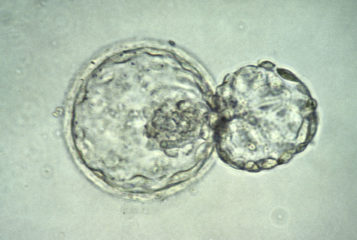|
Biotechnology and Cloning Edited by Lisa Firth Published by Independence Educational Publishers ISBN-10: 1861685874, ISBN-13: 978-1861685872 Buy this book from Amazon UK |
'Biotechnology and Cloning' is part of a series of educational books for teenagers addressing 'contemporary social issues'. It is an unusual concept, being neither a textbook nor a revision guide. It does not directly explain the underlying science, but outlines and encourages the reader to think around the topics.
The book is separated into three chapters covering biotechnology, animal cloning and human cloning. The chapters are then made up of a series of smaller pieces, each written by different organisations in different styles; including essays, newspaper articles and campaign propaganda.
At the beginning there is a small text box entitled 'A note on critical evaluation'. This outlines how to use the book; in particular the reader is encouraged to think about elements including 'the origin of the text and whether the source is likely to have a particular bias'. These instructions would benefit from a more prominent position, as they nicely lay out the point of the book — currently they are rather hidden away in the bottom corner of the page.
This edition was published in 2011 and is therefore bang-up-to-date, covering topics such as the position of Europe on biotechnology, written by the European Union; cloning animals for food, with a witty article by the Guardian's Leo Hickman titled 'Why I'd happily eat lab-grown meat'; and stem cell research, written about by the Irish Council for Bioethics and the Telegraph among others. The book ends with 'Key Facts', summarising (you guessed it) the key facts; as well as a short glossary and a page of student assignments, some of which are more involved than others.
Given that this book is full of terminology and scientific language, the glossary should have been really useful, but it left me disappointed. It is not very comprehensive, leaving out some of the more obvious candidates, and some of the descriptions contain more complicated jargon than the term they are attempting to explain. It is encouraging that this book does not dumb down for a teen market but often a simpler word would have done the job with no loss of accuracy.
Overall the format is well thought out, the layout is clear and the book feels cohesive, with footers and side headers used to great effect. Presumably due to budgeting restraints, the only available colour is a rather uninspiring shade of green, the illustrations are sparse and the diagrams and charts are miniscule. However I think this lack of pictures and mature presentation might appeal to some students who want to feel like they are being addressed as adults, rather than being given the Technicolor childish offerings that are more typical of this genre.
Whilst it is targeted at 14-18 year olds, 'Biotechnology and Cloning' assumes a high level of knowledge on an ambitious range of hard to grasp topics, none of which are directly explained in the book. For this reason it needs to be used under the guidance of a confident teacher who is well practised in teaching the background, and has a deep enough understanding to go further into the surrounding issues. Having discussed the content with a secondary science teacher, he was of the opinion that the age rating is a little off target for the amount of knowledge presupposed. He suggested that, at best, the lower age would be a high-achieving 16 year old.
The book encourages, if not requires, group debate and may be best placed for use in a science club, rather than in a typical lesson. If used to its full effect, the book offers a useful resource for teaching students how to think about science. Future generations will need to be more and more adept at this skill with society's increasing reliance on technology. This book is therefore a timely addition to the teacher's arsenal.
Buy Biotechnology and Cloning from Amazon UK.







Leave a Reply
You must be logged in to post a comment.